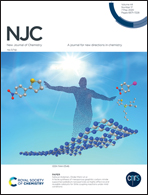Harvesting greenish blue luminescence in gold(i) complexes and their application as promising bioactive molecules and cellular bioimaging agents†
Abstract
Three novel highly photoluminescent mononuclear AuI compounds (1, 2, and 3) based on mixed phosphine/thiocarbamoyl-pyrazoline materials were synthesized at good yields using a sonochemical method and then structurally characterized. X-ray diffraction studies revealed the compounds to be mononuclear cationic complexes of the [Ph3PAu(L)]PF6 type with linear coordination geometry around AuI atoms. Investigation of photophysical properties showed an intense greenish blue emission when the complexes were excited at 305 nm in solution. The emission was attributed to mixed MLCT + IL and LLCT electronic transitions taking place after ligand complexation, as shown by DFT calculations. Full characterization of the compounds also comprised 1H and 13C NMR experiments, elemental analyses, infrared spectroscopy, and absorption–emission studies. Additionally, compounds 1, 2, and 3 and respective ligands were investigated as antibacterial agents against five Streptococcus aureus strains (Gram-positive) and one Escherichia coli strain (Gram-negative) with distinct antibiotic-resistance profiles. Cytotoxic activity was assessed using the MTT method against B16F10 melanoma, 4T1 mammary carcinoma, and normal BHK-21 baby hamster kidney cell lines. The synthesized AuI compounds proved more active than the respective precursors and free ligands. Tested as probes for cellular bioimaging, the complexes showed good biodistribution in the cytoplasm of MCF-7 and MDA-MB-231 (human breast adenocarcinoma cell lines).



 Please wait while we load your content...
Please wait while we load your content...